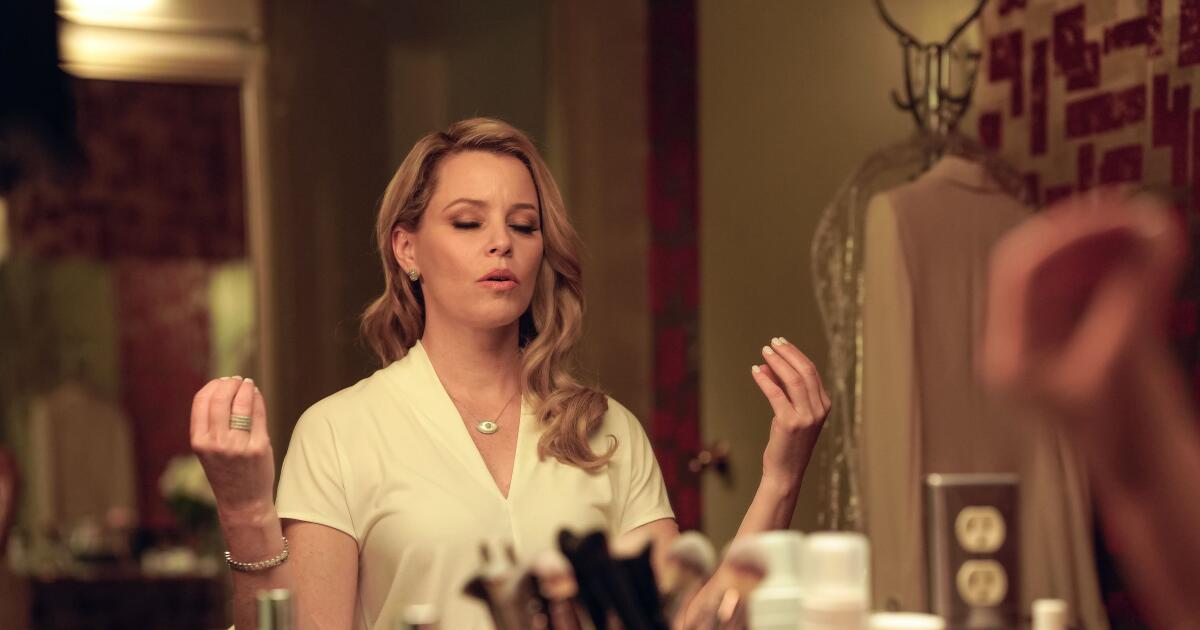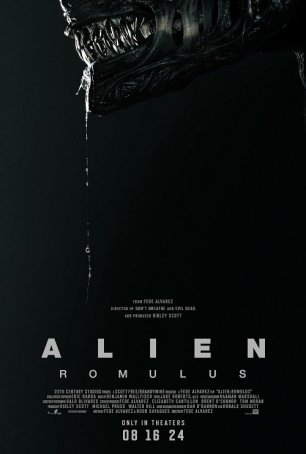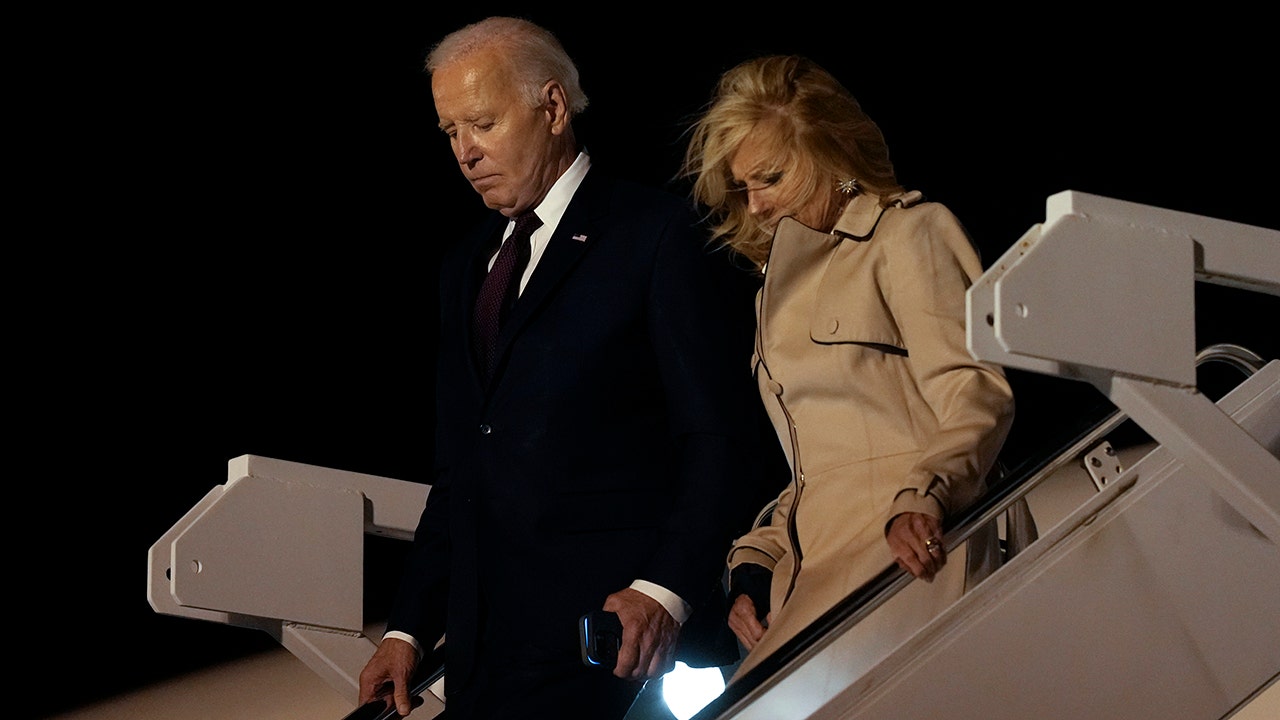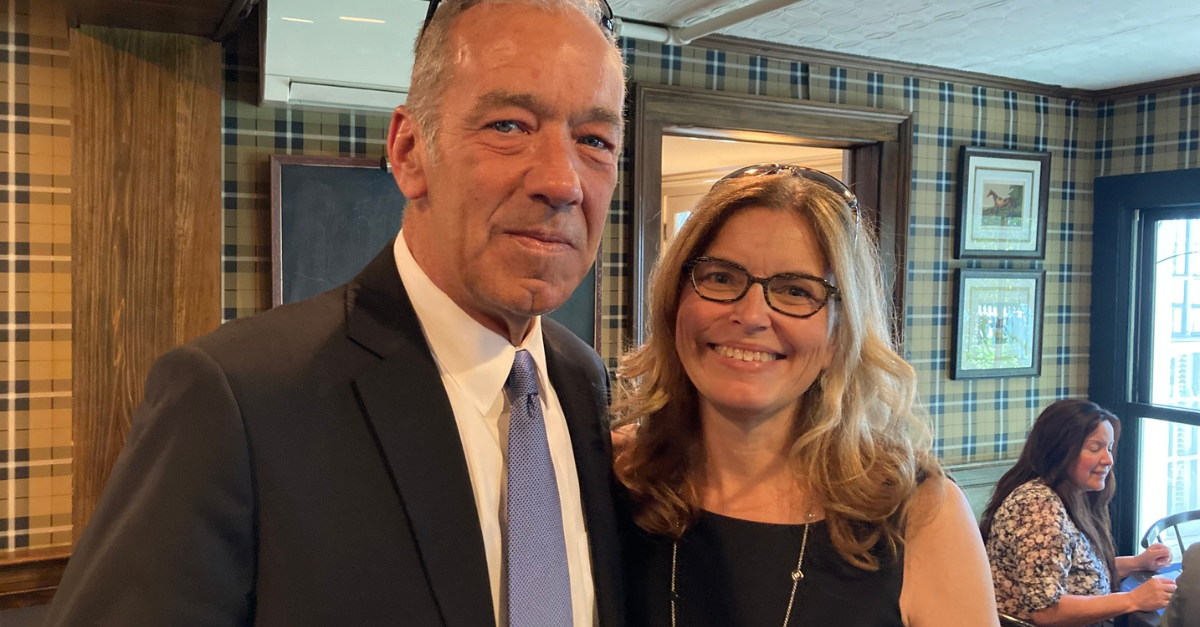Entertainment
Review: In 'Skincare,' cutthroat competition in the L.A. beauty industry leads to a face-plant

Director Austin Peters makes his narrative feature debut with “Skincare,” a slice of nasty L.A. noir set within the beauty industry, starring Elizabeth Banks as a celebrity aesthetician whose reputation crumbles around her over the course of two weeks. The film calls to mind other dark, salacious thrillers that satirize a city seemingly obsessed with image — think of “Nightcrawler” or even “American Gigolo” — and Peters wields the style and tone of this subgenre with skill.
The sunbaked Los Angeles of “Skincare” is not the glowing, golden fantasy that we often seen on screen, an impossibly beautiful escapist fantasy. No, the light in “Skincare” is harsh and revealing: bright UV rays, fluorescent bulbs and neon signs beating down on the face of Hope Goldman (Banks), a facialist with a high-profile client list who’s on the verge of breaking through to the big time with her own skincare line.
Hope has been desperate to keep up appearances with her product launch, taping a TV segment that she expects will catapult her into fame and fortune, but as we come to find out, her finances are in disarray. She’s behind on the rent for her storefront and spa in the iconically kitschy Crossroads of the World complex in Hollywood, and when a competing aesthetician, Angel (Luis Gerardo Méndez), sets up shop on her turf, an already frazzled Hope begins to unravel.
But Hope’s undoing isn’t entirely her fault: A mysterious stalker simultaneously starts to interfere with her reputation, sending creepy texts with videos of Hope attached, hacking her email and slashing her tires. Hope turns to her only allies, a group of lecherous men that includes a TV news anchor (Nathan Fillion), her mechanic (Erik Palladino) and a new friend, Jordan (Lewis Pullman), a young, amped-up life coach.
Elizabeth Banks and Lewis Pullman in the movie “Skincare.”
(IFC Films)
“Skincare” becomes a two-hander, alternating between the floundering Hope and the equally flailing Jordan, who desperately wants to be seen as a hero to her. Pullman is delightfully slimy as an unhinged delusional narcissist, high on his own supply of motivational word salad that he spews into his laptop camera. He’s a descendant of Tom Cruise’s “Magnolia” character Frank T.J. Mackey, but with all the wits of one of Michael Bay’s lunkheaded “Pain & Gain” crew.
Banks, on the other hand, brings a flinty mean streak to the striving Hope. Though she’s a victim here, she’s not entirely sympathetic and Banks tiptoes that fine line carefully. There’s a dash of schadenfreude here, since she cares more about what people think and how she looks than anything else. Her own assumptions and accusations add to the pile-up of miscommunication that lead to destruction in “Skincare.”
Banks’ and Pullman’s deliveries of these tragicomic characters elevate what could have been merely a genre exercise into something more fascinating and satirical. The script, written by Peters with Sam Freilich and Deering Regan, is less interesting. The coincidences and twists fit together, but there’s no deeper reason why this story had to be set in the beauty industry except that it’s a business built on facade, fantasy and seeming frivolity. “Skincare” doesn’t dig into any of these themes in a significant way. There is also no discernible reason why this story is set in 2013, except that it makes it feel slightly dated and cheesy; the diegetic Maroon 5 and Katy Perry songs that weave throughout the movie give it an ironic humor and sense of time, but this film did not have to be a period piece.
Despite his screenplay’s limitations, Peters (like Hope) is a master of aesthetics and with cinematographer Christopher Ripley and editor Laura Zempel, he‘s crafted a compellingly sleazy ‘80s-style thriller — or at least a convincing facsimile of one. The story may be only skin-deep, but Banks and Pullman find something truthfully hopeless in these surface pleasures.”
Katie Walsh is a Tribune News Service film critic.
‘Skincare’
Rated: R, for sexual content, graphic nudity, language throughout, some violence and brief drug use
Running time: 1 hour, 34 minutes
Playing: In wide release

Movie Reviews
Alien: Romulus | Reelviews Movie Reviews

(Contains spoilers about a certain cameo.)
A case could be made that Fede Alvarez’s Alien: Romulus
is the third-best film of the nine movies to feature the infamous xenomorphs (with
the prequel Prometheus being the only one not to name-check them in the
title). Romulus, which is positioned as a “side-quel” set in between Alien
and Aliens, eschews some of the more ambitious plotting that
characterized the least-popular franchise entries in favor of a straightforward
narrative. Alvarez, obviously an Alien devotee, opts for an Alien/Aliens
“greatest hits” approach replete with Easter Eggs and instances of fan service.
It mostly works although the tension never quite escalates to the levels
reached by Ridley Scott’s original and James Cameron’s even-better direct
follow-up.
The time-frame is 20 years after the xenomorph rampaged
through the Nostromo before being blown out the airlock by Ripley. (This
event is explicitly referenced although Ripley is not named.) The body of the
alien is retrieved and brought on board the space station Romulus/Remus
for experimentation. Shortly thereafter, we are introduced to several workers
toiling away terraforming a rather inhospitable planet. Rain (Cailee Spaeny),
who has been harboring dreams of escaping the dreary world for someplace where
the sun shines, discovers that the Wayland-Yutani Corporation has unilaterally
changed her quota, pushing back her date-of-freedom for at least a half-dozen
years. Following this betrayal, she and her synthetic surrogate brother Andy
(David Jonsson) decide to join a small group of friends – her ex-boyfriend
Tyler (Archie Renaux), his sister Kay (Isabela Merced), her cousin Bjorn (Spike
Fern), and Bjorn’s girlfriend Navarro (Aileen Wu) – in an audacious scheme to
free themselves of Wayland-Yutani’s yoke.
Tyler and Bjorn have discovered the derelict Romulus/Remus
in high orbit above the planet and intend to take a small spacecraft to the
space station to salvage the cryostasis chambers that will allow them to travel
to a distant colony. Initially, things go as planned but, once the group boards
the station, it becomes clear that things did not go well for the previous
crew. The only “survivor” is the partially destroyed synthetic, Rook (which
uses the voice and image likeness of Ian Holm), who serves the Prime Directive
dictated by the Company. When an accident triggers the revival of a group of
facehuggers from their stasis pods, the stage is set for an impregnation and,
as always happens in an Alien movie, the subsequent “birth” results in a
fight-or-flight struggle for life between disadvantaged humans and the “perfect”
killing machine. In this case, as in Aliens, there’s more than one.
Some of the best bits of Romulus are direct
references to the beloved first two Alien films (although Alvarez also provides
more obscure callbacks to Prometheus, Alien: Covenant, and even the two
other sequels). Alvarez, a horror director by trade (having previously made Don’t
Breathe and the Evil Dead remake), knows how to set up a tensely
creepy scene (there are several of these, some involving facehuggers and/or the
mature alien) but isn’t as good when it comes to character development. One
area where both Alien and Aliens succeeded was in fleshing-out
secondary characters that would eventually become xenomorph-fodder. In Romulus,
the four supporting humans are paper-thin with one or two recognizable traits
each. Only Rain and Andy (and the relationship between them) seem worth the
screenplay’s time.
Set design establishes the divided space station Romulus/Remus
as another consistent module in the universe established by Scott and
embellished by Cameron. Everything here feels “lived-in” and borrows its aesthetic
not only from the previous Alien films but from the TV science fiction
series The Expanse. Creature appearance is faithful to that of
H.R. Giger’s original monsters with one new design. The decision to use Ian Holm’s
likeness (made with the agreement and cooperation of the actor’s family) is a
mixed bag. The way it’s used, for a half-destroyed android, diminishes some of
the downfalls of a CGI image recreation but it remains a distraction.
Cailee Spaeny, the young actress blazing a trail through Hollywood
(recent credits include Civil War and the title role in Priscilla),
fashions a character who’s more than a “poor man’s Ripley” but less than a
force of nature. It’s impossible not to compare her to Sigourney Weaver but
that feels unfair. (Ripley, for example, received most of her development in Aliens
– for the majority of Alien, she was part of the ensemble.) Spaeny does
what she needs to do in providing viewers with a port of entry into this world.
Her relationship with Andy, a glitchy synthetic refurbished by her father, is
more touching than any of the human/human pairings in Romulus.
Is Alien: Romulus the Alien film fans have
been craving since Ripley, Hicks, and Newt entered their cryo-sleep in 1986? Perhaps.
It contains most of the requisite elements and, if it doesn’t measure up to the
high standard established by Scott (who has a producer credit) and Cameron (who
provided suggestions to Alvarez), that’s only to be expected. It’s a good
showcase for the xenomorph in its various permutations and a solid horror/suspense
movie in its own right. The open question is whether it will reinvigorate the franchise
after numerous misfires and cash-grabs. Only time (and the box office) will
tell.
Alien: Romulus (United States, 2024)
Movie Reviews
‘WE ARE ZOMBIES’ (2024) – Movie Review – PopHorror

I just watched We Are Zombies , the latest release from Screambox. The film starts by closing in on a zombie walking down the street. Sound familiar? Do the similarities end there?
Check out the trailer below, then read on for my thoughts.
Synopsis
When the dead are back, what do we do with them? RKSS (Turbo Kid, Summer of ’84) offers a fresh take on the undead in the SCREAMBOX Original We Are Zombies, streaming everywhere August 13.
In a city infested with the living-impaired — also known as non-cannibal zombies — three slackers after easy money must fight small-time crooks and an evil megacorporation to save their kidnapped grandma.
The directing team RKSS — François Simard, Anouk Whissell, and Yoann-Karl Whissell — wrote and directed the film. The story is based on the comic book series The Zombies That Ate the World.
It stars Alexandre Nachi (1991), Derek Johns (The Boys), Megan Peta Hill (Riverdale), Vincent Leclerc (The Revenant), Benz Antoine (Death Race), and Carlo Mestroni (Assassin’s Creed II) star.
Here’s a look at the poster art!
My Thoughts
What i loved about this movie was the storyline and how it stayed consistent. I love the characters and the zombies. I love the music and the way they used historical figures like Mother Theresa. What I didn’t like about the film was the amount of gore. I felt there should have been more gore and more blood. Yes, there were a couple of scenes, but for my money, I could have used some additional. I also wish they would have explored more of the girls storyline.

Final Thoughts
In closing, I would recommend this movie to anyone who likes action, horror and zombie flicks. Also fair warning it is raunchy, so might not want to show kids unless they are teens.
If I get the chance to watch it again, I will.
We are Zombies is streaming on ScreamBox as of August 13th.
Entertainment
How 'Shōgun' cinematographer Sam McCurdy helps create a visual portrait

Cinematographer Sam McCurdy knew he was part of something special during his nearly year-long tenure on FX’s “Shōgun,” where he shot five episodes of the 10-part historical epic set in 1600s Japan. But the U.K. native noticed something different leading up to its premiere as the network rolled out one of its biggest campaigns to launch a show in recent history.
“I remember driving into Los Angeles from Altadena going over the canyon roads, and somewhere in the middle of Glendale there were posters for the show,” he says. “I was like, ‘Oh, they made it way out here. That’s really cool.’ And I remember seeing trailers at the cinema too. There was something that felt old-school about ‘Shōgun.’ It was more like an event.”
The sprawling reach paid off, both critically and among audiences, as the premiere broke FX domestic and international streaming records. When Emmy nominations were announced, the success continued as creators Justin Marks and Rachel Kondo told the L.A. Times’ Tracy Brown it was “surreal” for “Shōgun” to lead the way with 25 nominations, including nods for series, acting, production design, costume design, sound, editing and visual effects.
“We don’t do this for the awards, we do it because we love the work,” says McCurdy, who was nominated for the gripping, albeit harrowing episode “Crimson Sky,” in which one of the series’ more beloved characters dies. “But I will be eternally grateful to production designer Helen Jarvis and costume designer Carlos Rosario for putting a kind of quality in front of the camera that I hadn’t seen for years. It was breathtaking. The costumes, the set design, everything was just incredible to photograph every day.”
Production nestled in British Columbia connecting with the lush Canadian surroundings for exteriors, including an old cedar mill to fill in for the fishing village of Osaka, while Mammoth Studios in Burnaby was home to the ornate sets built for the palace quarters, ceremonial hall and samurai houses. Cinematographer Christopher Ross established the visual table in the first two episodes (the pilot “Anjin” earned him his own Emmy nom) and it was up to McCurdy to expand the language to support a magnetic story of civil unrest among five council regents ruling the country, with two of them — Toranaga (Hiroyuki Sanada) and Ishido (Takehiro Hira) — in a chess match for power.
Cosmo Jarvis as John Blackthorne and Anna Sawai as Toda Mariko in “Shōgun.”
(Katie Yu / FX)
McCurdy also illuminated a blooming relationship between a captured Englishman named John Blackthorne (Cosmo Jarvis) and an interpreter in Lady Toda Mariko (Anna Sawai), which peaks in Episode 4, “The Eightfold Fence.” Teaming with director Frederick E.O. Toye, the pair discussed a theme of romance. “That gave us a shorthand for the visual language that was gentler and softer, where the camera movement was always around them trying to bring them together,” notes McCurdy. Highlighting the dance were scenes of Blackthorne and Mariko conversing atop a rocky outcrop and later in a softly lit natural pool before eventually sharing a bed. The cinematographer composed shots with longer lenses and had characters share the frame to outline their affection. “I like to think we did it subtly enough for viewers to take it on as a wave of feeling as opposed to us being pragmatic with our rules,” he says.
However, the relationship comes to a halt when Mariko’s husband, Buntaro (Shinnosuke Abe), thought to have been killed, unexpectedly returns. “Episode 5 was the breakup and we go with more visceral, harder framing,” McCurdy says. A perfect example of the stylistic choice occurs during a tense dinner scene where Blackthorne attempts to outdrink Buntaro while sharing war stories. It leads to Buntaro showing off his archery skills by having Mariko stand outdoors in the pathway. The shots narrowly miss her as he aims for the garden beyond. “The camera movement becomes more rigid and pointed then,” McCurdy notes. “Instead of gliding into a closeup, we go to a closeup and stay or move around to change your perspective.”
For Episode 7, “A Stick of Time,” which sees Toranaga’s half-brother enter the fray, an almost monochromatic color palette was introduced with the entire episode devoid of sunlight. “If it wasn’t for the firelight, it is almost a black-and-white episode,” McCurdy says. “In prep, Justin [Marks] had noted that ‘a mist rolls into town,’ and when I spoke to him about it he said it was the prevailing mist that was going to take over for the rest of the episodes. So we wanted to embrace the British Columbia climate and dig into the mist, the rain, the dirt, the mud and everything else. That was like music to my ears.” The painterly aesthetic was helmed by Japanese filmmaker Takeshi Fukunaga, who brought his own sensibilities to set. “He had a real way of dealing with the cast that was unlike anybody else,” McCurdy says. “It was the first time the cast could sit and chat in their own language and you could really feel the ease and how comfortable everyone was.”
In “Crimson Sky,” McCurdy sought to “drive the Mariko story” by showcasing “the weight the character earned through the rest of the season.” What it meant was lensing a visual narrative around Mariko’s strength and connecting the camera to her perspective. “We were going to treat Mariko very singularly,” he says. “She was going to stand proud of everybody else in the great hall scene, in the fight sequence or anywhere within her own space.” The resulting decision comes in a pinnacle moment when Mariko tries to lead her retinue out of Osaka only to be stopped by castle guards. With each shot, including overhead views, the camera reinforces Mariko’s bold ambitions as she becomes the focal point of the story
Even with each episode meticulously planned, McCurdy gave way to the performances, especially in Episode 10 when Blackthorne invites Usama Fiji (Moeka Hoshi) to say goodbye to her infant child who was sentenced to death as part of her husband’s seppuku. “The time between Episodes 4 and 5 and 9 and 10 gave us a chance to know how to subtly play with the characters,” notes McCurdy. “It’s a scene where you naturally respond to the performance and you don’t want to force anything. You don’t want to over-cover it so that it becomes a fiasco in the edit. The cast always informed us how we were going to photograph something, and it was always about their performances.”
-

 Ohio4 days ago
Ohio4 days agoOhio taxpayers sent families $966 million for private school tuition: Capitol Letter
-

 News1 week ago
News1 week agoNewly released video shows chaos and confusion after Trump assassination attempt
-

 World6 days ago
World6 days agoWhat could an EU Commissioner do to tackle the housing crisis?
-

 Politics1 week ago
Politics1 week agoTrump campaign frames election is 'complete contrast' against Harris record
-

 Politics1 week ago
Politics1 week agoTim Walz 'misspoke' about using weapons ‘in war,' Harris campaign says: report
-

 Politics1 week ago
Politics1 week agoProgressive women's groups silent on second gentleman Doug Emhoff's affair
-

 Politics1 week ago
Politics1 week agoBiden hunkers down at Delaware beach house after only public event of the week
-

 News1 week ago
News1 week agoPhotos: Family of Michael Brown Jr. marches on Ferguson 10 years later














